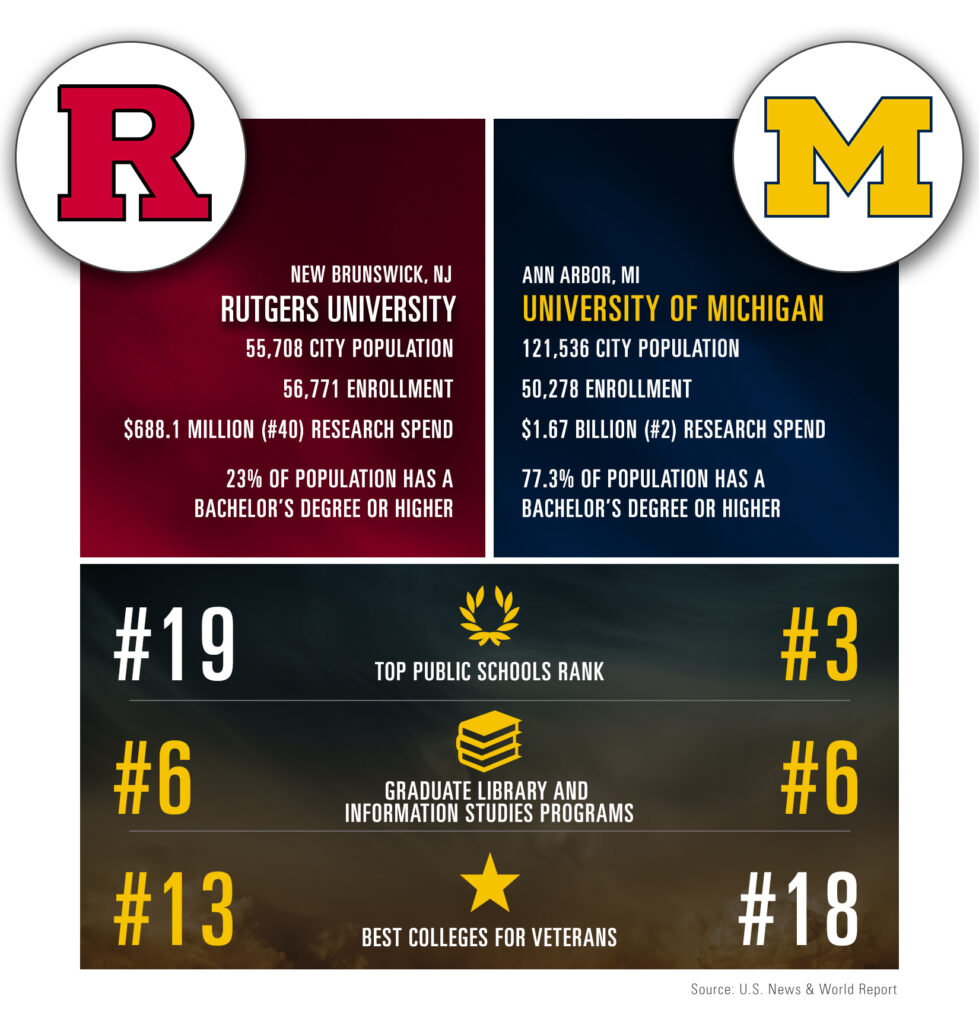
Week 10: Saturday, November 5, 2022 | Michigan vs. Rutgers | SHI Stadium | 7:30pm EST
Ann Arbor SPARK’s popular football blog series is back for Michigan’s 143rd season! We use the football season as an opportunity to compare Ann Arbor to cities around the country represented by our U-M football competition. The question is always – how does Ann Arbor compare to other college towns in the U.S.?
This week, the undefeated Wolverines move on to play the Scarlet Knights from Rutgers on Saturday evening at SHI Stadium. Rutgers, the “Birthplace of College Football,” is known for establishing one of the very first American college towns. As the nation’s eighth oldest institution of higher learning — one of only nine colonial colleges established before the American Revolution — Rutgers is steeped in both American and college football traditions.

So, how do we compare to this American staple?
- New Brunswick is much smaller than Ann Arbor (about half the size), though Rutgers has a larger student body enrollment.
- Though not a large city, New Brunswick is within 25 minutes of Newark, and about 60 minutes of New York City.
- New Brunswick is just one town in the midst of others of similar populations, unlike Ann Arbor, where the population is more concentrated.
- Ann Arbor is more affordable in terms of cost of living, making the median household income in New Brunswick slightly higher, albeit less powerful when compared to the median household income in Ann Arbor.
Be on the lookout for our blog posts ahead of each game all season long and be sure to tag us when you share these interesting tidbits with your friends via social media! And, if you want more information like this or are curious to learn more about the Ann Arbor region and what makes it such a great place to live, work, and locate your business in, please reach out to our Director of Research, Melissa Sheldon.
In case you missed it, here are links to the regional comparisons we’ve posted so far this year:
- Week 1: Ann Arbor vs. Fort Collins
- Week 2: Ann Arbor vs. Honolulu
- Week 3: Ann Arbor vs. Storrs Mansfield
- Week 4: Ann Arbor vs. College Park
- Week 5: Ann Arbor vs. Iowa City
- Week 6: Ann Arbor vs. Bloomington
- Week 7: Ann Arbor vs. State College
- Week 8: Bye Week
- Week 9: Ann Arbor vs. East Lansing
Sources
Where do we get our numbers? And what do they mean?
- Population data comes from the U.S. Census, 2021 Population Estimates. Check out Ann Arbor’s data.
- Enrollment data comes from the Integrated Postsecondary Education Data System (IPEDS). Review University of Michigan data.
- Research expenditure data comes from the National Science Foundation. View the Rankings by Total R&D Expenditures.
- Educational attainment data comes from the US Census 2016-2020 American Community Survey Five-Year Estimates. We look specifically at the population over the age of 25, and the highest level attained. Check out Ann Arbor’s data.
- The rankings come from U.S. News and World Report unless otherwise noted.